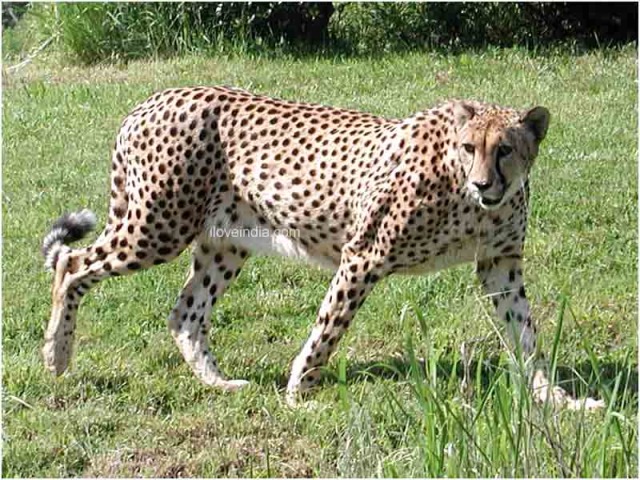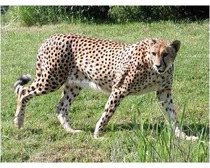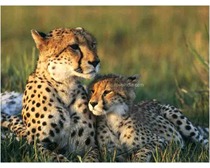There are several facts about cheetah which will surprise you. Read on to find all the interesting facts and amazing information on cheetahs.
Facts About Cheetah
Cheetah is the fastest land animal, known for its extremely quick speed. The animal is usually found in open savannas. Its full body is covered with fur and is tanned with round black spots throughout. It has no spots on the white underside of the body. However, there are spots on the tail, which merge to form four to six dark rings towards the end. Cheetahs have the distinct black “tear marks”, which extend from their eyes to their mouth. These marks help prevent the strong sunlight from hitting their eyes and also aid them in hunting. We bring you some more interesting facts and amazing information on cheetahs, in the lines below.

Facts About Cheetah
Kingdom: Animalia
Phylum: Chordata
Class: Mammalia
Order: Carnivora
Family: Felidae
Subfamily: Felinae
Genus: Acinonyx
Species: A.jubatus
Binomial Name: Acinonyx jubatus
Shoulder Height: 2.3 – 2.8 ft
Body Length: 115-135 cm
Tail: 84 cm
Weight: 88 -140 lbs
Life Span: Up to 12 years in the wild; Up to 20 years in captivity
Diet: Carnivorous; feeds on gazelles, antelope, hares, rodents and sometimes zebra
Habit: Males live in small groups; females live solitary life
Age of Maturity: 12 months (males); 20-24 months (females)
Mating: Throughout the year
Call: Chirping, churring, growling, yowling and purring
Gestation Period: 90-98 days
Number of Offspring: 2-9 cubs (average litter size: 3 to 5)
Interesting & Amazing Information On Cheetahs
- The term “cheetah” has been derived from Sanskrit word that stands for “variegated body”.
- Cheetahs rank as the fastest land animal in the world. They can run at a speed of 70 mph.
- Cheetahs have large nostrils that facilitate high intake of oxygen during the fast running motion. Besides, they also have enlarged lungs and heart that help in circulating oxygen effectively.
- While pursuing a chase, the respiratory rate of a cheetah goes as high as 150 breaths per minute.
- While running, cheetahs make use of their tail as well, which helps them in making sharp turns. Usually, prey animals use sharp turns to escape the predator and a cheetah’s tail helps it in defeating the prey in this aspect.
- Cheetahs are not successful in every hunt attempt. In fact, they have a success rate only around 50%.
- In just a few strides, cheetahs can increase their speeds many times. Though they are adept in running, they lack climbing abilities.
- Cheetahs are mainly guided by vision, rather than scent, during hunting.
- They behave differently from other “true” big cats. Unlike the big cats, cheetahs cannot roar while inhaling. Instead, they can purr during inhalation, something that the big cats cannot do.
- Cheetahs inhabit areas that have long stretch of land, which have ample presence of prey. They are more found in semi-desert, thick bush and prairie type of vegetation.
- Female cheetahs catch live prey. to use them for teaching their cubs about hunting.
- Cheetah cubs are very often attacked by predators. Their infant mortality is estimated to be around 75 %.
- Cheetahs are more active during the day, than at night.
- They are vulnerable to disease, owing to the shortage of genetic diversity in the population.
- For a period of 18 months after birth, cheetahs normally do not wander out by themselves.
- Cheetah cubs have an elongated gray-blue coat and black underbelly that, with the passage of time, becomes light colored and turns spotted.
- Unlike other cats, cheetahs bear their spots from birth. They also have downy underlying fur on their necks, which is called mantle. Their mantle extends up to the mid-back and sheds with the growing age.
- Cheetah cubs begin to grow independent of their mothers once they are between thirteen and twenty months.
- King Cheetah is a rare species of cheetah that is characterized by a unique pelt pattern.
- Cheetahs use their bold black lines around their muzzle to make several facial expressions. These expressions convey their mood aptly.
- They quench their maximum thirst from the bodies of their prey. So, they have very less need of water.


See also
More from iloveindia.com
- Home Remedies | Ayurveda | Vastu | Yoga | Feng Shui | Tattoos | Fitness | Garden | Nutrition | Parenting | Bikes | Cars | Baby Care | Indian Weddings | Festivals | Party ideas | Horoscope 2015 | Pets | Finance | Figures of Speech | Hotels in India : Delhi | Hyderabad | Chennai | Mumbai | Kolkata | Bangalore | Ahmedabad | Jaipur
- Contact Us Careers Disclaimer Privacy Policy Advertise With Us Lifestyle Sitemap Copyright iloveindia.com. All Rights Reserved.




